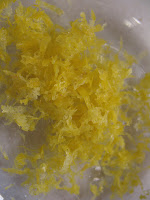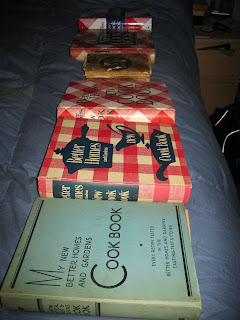 This Filled Cookies I recipe from All Recipes matches the Better Homes and Gardens on almost exactly for the ingredients. There is a mistake in the recipe, 1 egg is listed twice. It should only be there once for the dough, not the filling. Down to the Vanilla Extract are the ingredients for the cookie, below that is for the filling (excluding the egg). The instructions are a little different too, but overall it's close enough.
This Filled Cookies I recipe from All Recipes matches the Better Homes and Gardens on almost exactly for the ingredients. There is a mistake in the recipe, 1 egg is listed twice. It should only be there once for the dough, not the filling. Down to the Vanilla Extract are the ingredients for the cookie, below that is for the filling (excluding the egg). The instructions are a little different too, but overall it's close enough.First check is to see out of my 6 cook book editions when this shows up and how it has changed. It looks like the first appearance is my 1976 cook book. It shows up in the two following cook books as well, but in the second following one it is an alternate to the Date Pinwheels which made me look back through all the books for that. As it turns out the Date Pinwheels are the same thing, just assembled differently. A sugar cookie dough with a date filling rolled up and sliced instead. So when I looked again, Date Pinwheels went back to the 1953 edition. So basically Date-Filled Cookies or Date Pinwheels were in every edition except the 1936 one.
The recipe varied slightly in the date filling (older recipes adding nuts to it as well.) And the cookie varied slightly as well, but it was pretty much a sugar cookie dough and date filling made with dates, sugar and water. It must have been a well liked recipe to keep making an appearance.
 Since the sugar cookies would be rolled out I decided it was time to try Rolling Pin Rings to keep the thickness consistent. I’ll talk about these more later. Dates would be nearly the only ingredient I’d need to get (and a lemon as well.) So easy to buy for. The only down side is that the packages of dates I got give you 1 ¾ cup of dates when the recipe calls for 2. So I’ve got some spare now.
Since the sugar cookies would be rolled out I decided it was time to try Rolling Pin Rings to keep the thickness consistent. I’ll talk about these more later. Dates would be nearly the only ingredient I’d need to get (and a lemon as well.) So easy to buy for. The only down side is that the packages of dates I got give you 1 ¾ cup of dates when the recipe calls for 2. So I’ve got some spare now.
The dough was a standard rolled sugar cookie dough, cream shortening, sugar, add other wet ingredients, then the dry ones, so I prepared that first and then put it in the refrigerator to chill for later and then started in on the filling.
I had assumed that the filling would have the fruit, some thickener, etc. But it turned out to be quite simple. The cut up dates, a little sugar, water, bring to a simmer and cook for 5 minutes. Tah dah! Date filling. After cooling it’s like thick preserves, perfect for a filling. Really neat.
So I let everything cool in the refrigerator until the next day. Next step was to roll out the sugar cookie dough to 1/8 of an inch. This was where the rolling pin rings would come in. The recipe recommended taking half the dough at a time to roll out. This probably works if you’re not using the rings to keep a consistent thickness.
With the rings I could press down and not worry about making the dough too thin, but I also was very restricted on how wide the dough could get. It had to fit between the two rings at each end of the rolling pin. You’d have the same problem with another solution, strips of a specific thickness on either side of the dough, but at least you could use a wider rolling pin.
So I actually rolled out about ¼ of the dough at a time. Even so, I still had to roll it long and narrow to fit between the rolling pin rings. I used a 2.5 inch circular cutter with a decorative edge and then a pastry scraper to carefully pick up each cookie. Even if the cookies were kind of stuck to the surface a bit, just jiggling the scraper under them lifted them off very cleanly. I placed my usual number of cookie bottoms on the sheet (rows of 4, 3, 4, 3, and 4, so 18 cookies to a sheet)
The recipe then called for using a teaspoon of filling. Now it gets confusing, do they mean a measuring teaspoon or an eating teaspoon? I chose to use a measuring teaspoon very slightly heaped to measure out the filling.
Next it was time to lay a second cookie over the first. I slightly squished down the filling a bit when I did this. The amount of filling sometimes cause the top of the cookie to crack a bit when I pushed down the edges, but the look was not unattractive.
Then I sealed the two layers of cookies together using the back of a regular spoon as recommended. I suppose someone could get very fancy with this, but I just did a serviceable job. Some of the editions of this recipe recommend using fork tines instead to seal the edges.
Next, bake for 10-12 minutes. I was anxious to see how they came out. They were slightly browned at 11 minutes so I used that time. They looked pretty good on the cooling rack, and when I tried them I was surprised how good they were. For a recipe I wouldn’t have given a 2nd glance at, they were very tasty and I ate a good number of them over the holiday weekend.
 |
| Dates in the sauce pan with water and sugar before cooking. |
 |
| Date filling after cooking 5 minutes. |
With the rings I could press down and not worry about making the dough too thin, but I also was very restricted on how wide the dough could get. It had to fit between the two rings at each end of the rolling pin. You’d have the same problem with another solution, strips of a specific thickness on either side of the dough, but at least you could use a wider rolling pin.
 |
| Circles cut into the dough. |
 |
| Bottoms on the cookie sheet. |
 |
| Slightly heaping teaspoon of filling on the cookies. |
 |
| Edges pressed together with back of the tip of a spoon. |
Next, bake for 10-12 minutes. I was anxious to see how they came out. They were slightly browned at 11 minutes so I used that time. They looked pretty good on the cooling rack, and when I tried them I was surprised how good they were. For a recipe I wouldn’t have given a 2nd glance at, they were very tasty and I ate a good number of them over the holiday weekend.
 |
| The finished Date-Filled Cookies on the cooling rack. |
They also went over well at work. I’d definitely make them again. They were like little mini pies, but the cookies as the container instead of pastry made them even better.
Lessons Learned:
Roll out in smaller batches, or use strips and a wider rolling pin.
Save all the scraps from cutting out cookies to recombine all at once to ensure you don’t get too much flour into the dough rather than trying to reuse the scraps from a roll out of ¼ of the dough over and over.
A slightly heaped teaspoon did not use up the filling, I could have done more. Interestingly the later versions of this recipe only use 1 and ⅓ cup of dates instead of two, so maybe there is too much filling.
I could probably flatten the filling out a little more to make it more even before layering the 2nd cookie on.
Next time try sealing the cookies together with fork tines.



























